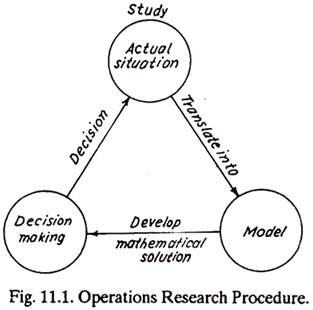After reading this article you will learn about:- 1. History of Operations Research 2. Definition and Concept of Operations Research 3. Methodology 4. Applications.
History of Operations Research:
Historically, the term Operations Research originated during Second World War when U.S.A. and Great Britain’s Armed Forces sought the assistance of Scientists to solve complex and very difficult strategical and tactical problems of warfare, like making mines harmless or increasing the efficiency of antisubmarine aerial warfare, etc.
Operations research employs mathematical logic to complex problems requiring managerial decisions.
Operations research aids, in solving diverse business problems and in planning and investigation of major operational decisions.
Definition and Concept of Operations Research:
Operations Research signifies research on operations. However, it takes into consideration a particular view of operations and a particular kind of research. Operations research is the organised application of modern science, mathematics and computer techniques to complex military, government, business or industrial problems arising in the direction and management of large systems of men, materials, money and machines.
The purpose is to provide the management with explicit quantitative understanding and assessment of complex situations; to have sounder basis for arriving at best decisions. Operations research seeks the optimum state in all spheres and thus provides optimum solution to organisational problems. It is of considerable value in Production Management.
Methodology of Operations Research:
Various steps involved are as follows:
(1) Understand the actual real situation, capture the same and define the problem.
(2) Formulate a mathematical model.
Formulate a mathematical model:
A model is of great help in facilitating the investigations of operations and operations research expresses a problem by a model. The model covers the relationship of the variables/Generally two types of models are employed. An analogue model which takes the form of an electronic circuitry or (it may be) a mechanical system. The other, called symbolic model is in the form of a matrix, a graph or an equation. This is also known as mathematical model. Models provide solutions in quantitative form (cost, weight, etc.), depending upon the problem.
Operations research models can also be classified as probabilistic and exact models. Probabilistic models rely upon the probability theory and contain obvious recognition of uncertainty. They are very useful in advertising problems. In exact models, chance or uncertainty plays a very minor role, for example, as in long range production planning with orders already in hand.
(3) Develop a mathematical solution:
Data is supplied to the model. Information is computed, and results are analysed to find the mathematical solution for alternative policies.
(4) Interpret the solution and prepare the information in such a form that it is meaningful, intelligible and quantitative translate it into a decision.
(5) Implement the decision to the real (actual) situation.
(6) Verify the results:
After applying the solution to real situation, the actual results produced by the model must be tested statistically and verified to explore any significant deviation from the expected results. If found so, the model can be modified and again the cycle is repeated (Fig. 11.1).
Applications of Operations Research:
A few applications of operations research are as under:
(a) Locating factories and warehouses to minimize transportation costs,
(b) Work allocation to machines for minimizing production time and costs,
(c) Inventory problems,
(d) Material handling,
(e) Dealing with waiting times,
(f) Equipment replacements,
(g) Dividing advertising budget,
(h) Establishing equitable bonus systems,
(i) Routing of tankers,
(j) Traffic control,
(k) Petrochemical mixes,
(l) Municipal and hospital administration, and
(m) Marketing, etc.
